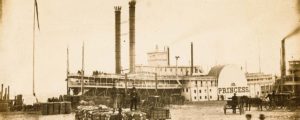 “India,” Madhusree Mukerjee says, “made Winston Churchill irrational. Unlike most British leaders, he refused to admit the Empire would have to change after the war, and did all he could to block it.” In Churchill’s Secret War, the Guggenheim Fellow traces India’s colonial history and overlooked wartime role. She also argues that Churchill’s attitudes toward his beloved Empire’s “crown jewel” fostered a famine that killed millions.
“India,” Madhusree Mukerjee says, “made Winston Churchill irrational. Unlike most British leaders, he refused to admit the Empire would have to change after the war, and did all he could to block it.” In Churchill’s Secret War, the Guggenheim Fellow traces India’s colonial history and overlooked wartime role. She also argues that Churchill’s attitudes toward his beloved Empire’s “crown jewel” fostered a famine that killed millions.
What was India like in 1939?
It had been a British colony for nearly 200 years. In the 1930s, Mohandas Gandhi drew millions of rural and village people into the National Congress Party, whose upper-class intellectuals, like Jawaharlal Nehru, spearheaded a nonviolent independence movement. Initially, the British repressed it harshly. But by 1939, most British politicians, though not Churchill, realized India had to be given concessions or be lost to the war effort.
Why was India vital?
India was paying millions to hundreds of millions of pounds to Britain every year, including defense costs, which increased by 17 times during the war. India was also extremely important to Britain’s war plans. Its location let you reach Southeast Asia, the Middle East, Australia—the entire British Empire. The Indian Army, the largest number of men the British could field, could be sent off to any war theater without the Indian government even being informed.
Did Indians support the war?
The Congress Party had three main schools of thought. Gandhi was very sympathetic to the British; he was horrified by Hitler and wanted to help win the war in nonviolent ways—economically, for example. Nehru, who had been to Europe, was also opposed to Hitler but felt it wasn’t clear what India would get out of the war. Subhas Chandra Bose, Congress’s president, saw the war as an opportunity to free India. They had a showdown in September 1939, and agreed to ask Britain about its war aims: Will they defend the colonial status quo, or will they involve democracy and self-determination? Congress passed a resolution saying if the latter were true, India would willingly join the Allies. The British Viceroy’s response made no mention of democracy.
How did Indians react?
Earlier in 1939, Bose had wanted to launch a civil disobedience movement along with an ultimatum to the British: get out in six months or it will be difficult to prosecute your war. Gandhi felt with so much violence in the air, it would be impossible to discipline Indians in nonviolence, and awful things would happen. So he engineered Bose’s political downfall. Then Gandhi realized the British weren’t going to give an inch, so he organized a very limited civil disobedience movement, satyagraha. People whose patience had been tested, like Nehru, gave antiwar speeches and were immediately arrested—25,000 of them. The British were unfazed. It was clear to most of them the Indian Army would fight.
Why would they fight?
Men from one family would go into the same platoon, men from the same village would be in the same battalion, and so on. So they would fight for each other. This had happened for generations, so ordinary soldiers were pretty loyal to the Empire.
What did Bose do?
In 1941, he went to the Italian embassy in Afghanistan. He said, “Give me 50,000 Axis troops; if they reach India’s borders, the entire Indian Army will defect and the British war effort will be crippled.” The Italians thought he was terrific and dispatched him to Berlin. He made it, although Churchill’s Special Operations Executive tried to assassinate him. The German Foreign Office was interested; Hitler wasn’t, because he still believed he could reach an accommodation with the British. So in 1943, Bose went to the Far East.
To meet the Japanese.
They arrived at India’s borders in 1942. This was total disaster; the British war cabinet hadn’t anticipated they could get that far. So the British Empire lost its sheen: Indians looked at Singapore’s surrender and the exodus from Burma and saw the British cutting and running and leaving everyone else to fend for themselves. In Malay, they’d formally handed Indian troops over to the Japanese. Some of those POWs formed the Indian National Army (INA), which numbered as high as 40,000 men, to liberate India; Bose led them. This was a crisis for the Allied effort.
How did Churchill respond?
Roosevelt urged him to reach an accommodation with the Congress Party, and the Labor Party put a lot of pressure on him. So he sent Stafford Cripps with a proposal offering Muslims a separate state; it was designed to make Congress reject it. Louis Johnson, FDR’s envoy, shuttled between Cripps and Congress, trying for an agreement that let Indians control the domestic war effort. Churchill sent furious telegrams to Cripps saying he could not negotiate, and rounded on FDR’s assistant, Harry Hopkins, in London. Hopkins realized Churchill was irrational about India, Johnson had the rug pulled from under him, and Congress rejected the proposal. When FDR pressured Churchill again, Churchill threatened to resign, so FDR subsequently refused to get involved in Indian affairs.
What resources did that leave to defend India?
About two million men, very lightly armed and not very well trained—certainly not capable of fighting the Japanese. When the Japanese arrived, seven Indian divisions were fighting in Iraq and Iran and North Africa. These were the very best, very well equipped and trained. General Archibald Wavell, commander-in-chief in India, pointed out India was drained of troops and couldn’t even defend itself, never mind Southeast Asia. The troops sent to Malaya and Burma were untrained; some hadn’t even shot a gun. They were sacrificed on that horrible retreat. The other key point was lack of air cover. India had 14 outdated bombers. In March 1942, Wavell estimated he needed 64 squadrons of fighters and bombers.
What stopped the Japanese?
The scorched-earth policy in northeastern India slowed them, but more importantly they were already choking on China. During 1943, India got nearly 500,000 reenforcements, including American, British, African, and Chinese soldiers. The 5th Indian Division was brought back from the desert and retrained for jungle warfare. In February 1944, with Bose heading the INA, the Japanese attacked at Imphal. That went disastrously. The British flew in the entire 5th Indian Division—an extraordinary logistical operation in this tiny valley—and supplied it with airdrops. This shows how important to the Allies Indian resources—steel, cement, timber, food—were, because it happened during the Bengal famine.
What started the famine?
The major cause was inflation. Nothing was coming into the country for civilians, but goods—food, ammunition—were being exported and paid for with paper money, which flooded urban areas. The paper money drew all available resources, especially food, into the city centers. Just then, in 1943 India had a short crop; prices shot up even more. With Burma’s fall, India became the British Empire’s major source of rice—though it previously imported 1 to 2 million tons of rice from Burma annually. The Viceroy told London, “I desperately need imports of wheat, at least 500,000 tons to feed the army and the most im-portant industrial workers.” The war cabinet said, “We don’t have the ships.” But actually there was no shortage of ships or grain. Churchill transferred all the shipping to the Atlantic.
Why?
To build up stockpiles. He was set on liberating the Balkans. The stockpiles were meant to supply Balkan civilians after the war. They got so big American and Canadian grain traders worried the British would use them to manipulate the postwar market; by 1943’s close, they held 18.5 million tons. Three million Bengalis died.
How did the famine end?
The military chiefs—Wavell, now viceroy; Alan Brooke, chief of the imperial general staff; and theater commanders like General Auchenlick and Lord Mountbatten—knew it was making many Indian and even British soldiers question the war’s rationale. They said repeatedly, “We can’t use India as a base while it’s suffering famine.” Much against Churchill’s wishes, they came up with a strategy: “We have room on our ships; we’ll carry the grain.” So in 1944 India got more than 600,000 tons of wheat.




